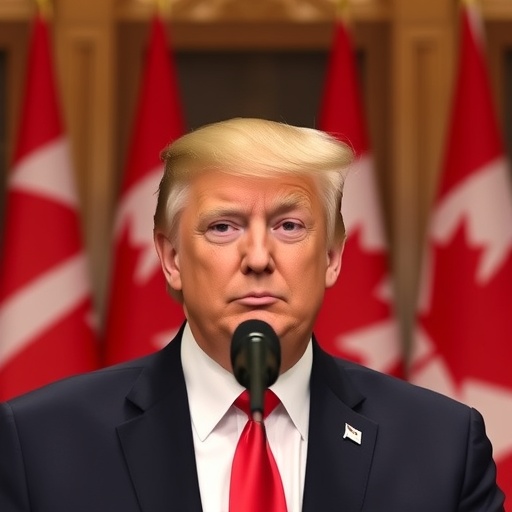In a stunning escalation of trade tensions, President Donald Trump has announced a 10% tariff increase on all Canadian imports, directly citing a provocative television advertisement aired by the Ontario government as the trigger. The ad, which repurposed words from former U.S. President Ronald Reagan to decry American tariffs, was branded a ‘hostile act’ by Trump, prompting him to cancel a planned bilateral meeting with Canadian Prime Minister Mark Carney at the upcoming ASEAN summit.
This move comes amid already fragile U.S.-Canada relations, strained by ongoing disputes over trade barriers. The tariff hike, effective immediately, targets a wide array of Canadian goods including lumber, automobiles, and agricultural products, potentially adding billions to the cost of cross-border commerce. Trump‘s announcement, delivered via a fiery White House press briefing, underscores his administration’s aggressive stance on what he perceives as unfair trade practices from America’s northern neighbor.
The Ontario ad, which began airing last week across major networks in the Great Lakes region, featured archival footage of Reagan warning against protectionism, overlaid with visuals of shuttered factories and rising consumer prices due to U.S. tariffs. ‘Tariffs are taxes on the American people,’ the ad intoned, using Reagan’s own phrase to highlight the economic fallout from Trump’s trade policies. Ontario Premier Doug Ford defended the campaign as a necessary response to protect provincial interests, but the backlash from Washington has been swift and severe.
Ontario’s Bold Ad Campaign Ignites Cross-Border Firestorm
The controversy erupted when Ontario launched its anti-tariff advertising blitz on October 15, aiming to rally public support against U.S. protectionism. The 30-second spot, produced by the provincial Ministry of Economic Development, cost an estimated $2.5 million and was broadcast in key U.S. markets like Michigan, New York, and Minnesota—states with heavy reliance on Canadian trade. By invoking Reagan, a Republican icon revered by Trump’s base, the ad sought to underscore the irony of current policies contradicting conservative free-market ideals.
According to Ontario government spokespeople, the campaign was inspired by recent tariff impositions on Canadian steel and aluminum, which have already cost the province over $1.2 billion in lost exports since 2018. ‘We’re not attacking America; we’re defending our workers,’ Premier Ford stated in a Toronto press conference. ‘Reagan understood that tariffs hurt everyone—it’s time for Washington to remember that.’
Viewership data from Nielsen indicates the ad reached more than 5 million households in its first week, sparking viral discussions on social media. Hashtags like #ReaganVsTariffs and #OntarioStandsUp trended in both countries, amplifying the message. However, U.S. conservative commentators, including Fox News host Sean Hannity, lambasted the ad as ‘foreign interference’ in American politics, setting the stage for Trump’s retaliatory rhetoric.
Economists note that Ontario, as Canada’s most populous province and a manufacturing powerhouse, exports over $100 billion worth of goods to the U.S. annually. The ad’s focus on auto parts and machinery—sectors employing tens of thousands in Windsor and Oshawa—highlighted vulnerabilities that Trump’s new tariffs could exacerbate. Provincial officials report that preliminary inquiries from U.S. buyers have already dipped by 8% since the ad aired, signaling early market jitters.
Trump’s Tariff Retaliation: A 10% Hit to Canadian Trade Flows
President Trump’s response was as immediate as it was inflammatory. During a rally in Ohio on October 20, he first teased the tariff hike, calling the Ontario ad ‘a slap in the face from Trudeau’s cronies up north.’ By the following day, the White House formalized the policy: a blanket 10% increase on Canadian imports, layered atop existing duties. This affects everything from maple syrup to heavy machinery, with the U.S. Trade Representative estimating an additional $15 billion in annual costs to Canadian exporters.
‘This is a hostile act against the United States,’ Trump declared in an official statement. ‘Canada thinks they can use our own heroes like Reagan to undermine our great American workers? Not on my watch. We’re hitting back hard to protect our economy.’ The tariffs, implemented via executive order under Section 301 of the Trade Act of 1974, bypass congressional approval and could remain in place indefinitely.
Historical context reveals a pattern in Trump-era trade wars. Since 2017, the administration has imposed tariffs on Canadian goods totaling over $20 billion, citing national security concerns—a justification repeatedly challenged by the World Trade Organization. The latest escalation revives memories of the 2018 steel and aluminum spat, which led to retaliatory Canadian tariffs on U.S. whiskey and yogurt, costing American farmers $300 million.
Market reactions were swift: The Canadian dollar fell 1.5% against the U.S. dollar within hours of the announcement, while Toronto’s TSX index dropped 2.3% in heavy trading. U.S. automakers like Ford and General Motors, which source 30% of their parts from Canada, warned of supply chain disruptions. ‘This tariff hike could raise vehicle prices by $500 per car,’ said Ford CEO Jim Farley in a statement, urging diplomatic resolution.
Statistics from the U.S. Census Bureau show that Canada is America’s largest trading partner, with bilateral trade exceeding $600 billion in 2022. Ontario alone accounts for 40% of that volume, making the province a linchpin in North American supply chains. Analysts from the Peterson Institute for International Economics predict the new tariffs could shave 0.5% off Canada’s GDP growth next year, while adding inflationary pressure south of the border.
ASEAN Summit Snub: Diplomatic Chill Between Trump and Carney
Compounding the economic blow, Trump explicitly ruled out a one-on-one meeting with Prime Minister Mark Carney at the ASEAN summit in Jakarta next month. The annual gathering, attended by leaders from 10 Southeast Asian nations plus dialogue partners like the U.S. and Canada, was slated to include a U.S.-Canada sideline discussion on trade normalization. Carney, a former Bank of England governor known for his steady-hand approach, had hoped to broker a de-escalation.
‘No meeting with Carney—tell him to fix that ad before he talks tariffs,’ Trump tweeted post-announcement, amassing 2.5 million likes in 24 hours. This snub marks a departure from traditional protocol, where such summits facilitate informal diplomacy. Canadian Foreign Minister Mélanie Joly expressed disappointment, stating, ‘Pettiness won’t solve our shared challenges. We’re committed to dialogue, even if it’s one-sided.’
The ASEAN summit, themed ‘Enhancing Connectivity and Resilience’ this year, comes at a pivotal time for global trade. With U.S.-China tensions simmering, Trump has positioned America as a counterweight in the Indo-Pacific, but alienating Canada could isolate Washington further. Carney’s office highlighted ongoing cooperation on issues like Arctic security and fentanyl trafficking, suggesting the tariff spat risks broader alliance strains within the USMCA framework.
Diplomatic insiders whisper that Carney, who assumed office in 2023 amid economic recovery efforts, views the summit as a chance to diversify Canada’s trade partners. Recent deals with ASEAN countries have boosted exports by 15%, but U.S. tariffs threaten to undo those gains. ‘Snubbing the meeting is a mistake that hurts both sides,’ said former U.S. Ambassador to Canada David MacNaughton. ‘Trade isn’t zero-sum; it’s interdependent.’
Behind the scenes, preparations for the summit are underway, with ASEAN Secretary-General Kao Kim Hourn calling for ‘restraint’ in North American disputes. Canada’s delegation, led by Carney, plans to use multilateral forums to voice concerns, potentially rallying support from like-minded nations.
Economic Ripples: Industries Bracing for Tariff Turbulence
The 10% tariff increase sends shockwaves through key sectors. In Ontario’s auto industry, which employs 120,000 workers and exports $50 billion to the U.S. yearly, executives are scrambling. Chrysler parent Stellantis announced a temporary halt to production at its Windsor plant, citing cost uncertainties. ‘These tariffs are a body blow to just-in-time manufacturing,’ said Unifor union president Jerry Diaz, representing affected workers.
Agriculture faces similar headwinds. Canadian dairy and poultry, already under USMCA quotas, could see export values plummet by 20%. The Canadian Federation of Agriculture estimates a $2 billion hit, with Ontario farms—producing 40% of national milk—hit hardest. ‘We’re not the enemy; we’re suppliers to American tables,’ said federation spokesperson Abbey Sinclair.
Lumber, a perennial flashpoint, adds fuel to the fire. U.S. builders rely on Canadian softwood for 70% of their needs, but ongoing duties have inflated home prices by 5%. The new tariffs could push median U.S. home costs toward $400,000, per National Association of Home Builders data. Environmental groups, meanwhile, praise the ad’s anti-protectionism message, arguing tariffs distort sustainable forestry practices.
Consumer impacts loom large. Everyday items like beer (Ontario’s exports top $1 billion) and appliances could rise 8-12% in price. Retailers such as Walmart and Home Depot, with deep Canadian ties, are lobbying for exemptions. ‘This isn’t just business; it’s about affordable living for families on both sides,’ said Walmart Canada CEO Stephanie Ross.
Broader economic forecasts paint a grim picture. The Conference Board of Canada projects a 0.3% GDP dip for Ontario alone, with unemployment ticking up 1% in trade-dependent regions. U.S. firms, too, stand to lose: A study by the U.S. Chamber of Commerce warns of 50,000 job risks in border states if retaliation escalates.
Path Forward: Navigating Trade Thaw or Deeper Divide?
As the dust settles, questions swirl about resolution. Canadian officials are mulling WTO complaints, echoing the 2018 victory that forced U.S. concessions. Prime Minister Carney has scheduled virtual talks with U.S. Commerce Secretary Gina Raimondo, aiming to negotiate tariff rollbacks tied to ad campaign pauses.
Trump’s team, however, signals no quick retreat. Advisors like Peter Navarro, architect of past trade wars, argue the move strengthens negotiating leverage ahead of USMCA reviews in 2026. ‘Canada needs to learn respect,’ Navarro told CNN. Yet, bipartisan voices in Congress, including Senator Chuck Schumer, urge de-escalation: ‘Tariffs on allies weaken us all against real threats like China.’
Looking ahead, the ASEAN summit could pivot tensions. If Carney secures endorsements from regional powers, it might pressure Trump to reconsider the snub. Alternatively, prolonged tariffs risk a full-blown trade chill, echoing the 1980s auto pact disputes that reshaped North American industry.
Experts like trade lawyer Simon Potter foresee a hybrid outcome: targeted exemptions for Ontario goods in exchange for toned-down rhetoric. ‘History shows these spats cool off, but not without pain,’ Potter noted. For now, businesses and policymakers brace for uncertainty, with the U.S.-Canada border—once a seamless lifeline—emerging as a new fault line in global economics.
In the coming weeks, stakeholder summits in Ottawa and Washington will test diplomatic mettle. Ontario’s ad may have sparked the fire, but quenching it demands mutual recognition of intertwined fates. As Trump and Carney chart courses, the stakes extend beyond tariffs to the enduring partnership defining two nations.










